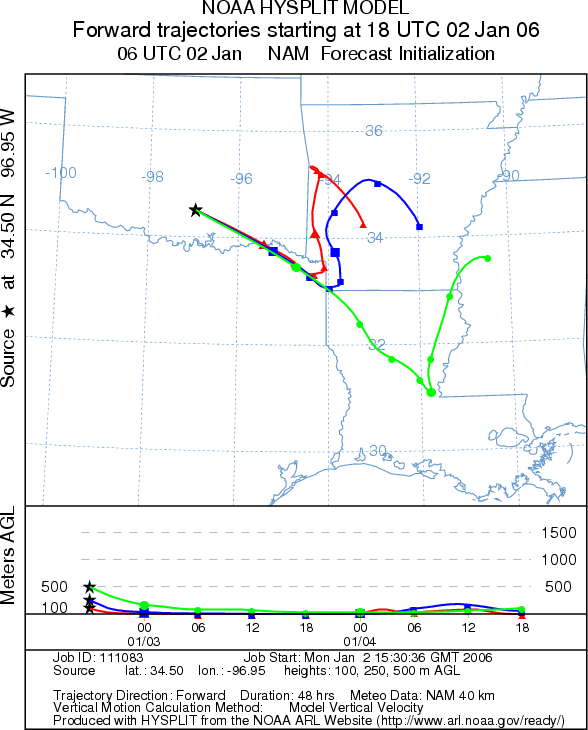The University of Tulsa
Mountain Cedar Pollen Forecast
Metropolitan Area |
Exposure Risk |
|
Oklahoma City |
Low |
|
Tulsa |
Low |
|
St. Louis MO |
Low |
Date Issued: 2 Jan 06
Mountain Cedar Location(s): Arbuckle Mountains, OK
Regional Weather: Mon.
and Tue., Jan 02 and Jan 03. TX/OK:
The Texas/Oklahoma area will continue to be warm and dry today and tomorrow with high pressure building to the
south and west. There is no foreseeable chance of precipitation throughout the region. A strong low pressure system
will continue to move just south of the Great Lakes region continuing to pull the trajectories to the north and
northeast. Winds start today from the west shifting towards a more south to north direction overnight and for
tomorrow. This low pressure will continue to fuel strong winds across the region further complicating current
efforts to control wild fires. Today’s temperatures will be cooler with highs in the low 60s across Oklahoma and
the upper 60s to low 70s in Texas. Humidity will remain low during the day with values in the 10-20% range in
west rising towards the east and north, but remaining below 40% region wide. Tomorrow, temperatures throughout
the region will become warmer with highs in Oklahoma reaching the 70s and Texas showing highs in the upper 70s
to low 80s. Nighttime temperatures will remain above average for this time of year, in the upper 30s to low 40s
in the north and low to mid 40s to the south.
Trajectory weather: The air mass trajectories move from
the Arbuckle Mountains to the southeast over northeastern Oklahoma and northeastern Texas, eventually turning north
at the lowest elevations. The trajectories are associated with sinking atmospheric conditions that are characteristically
poor for pollen entrainment and travel. Warm daytime temperatures, clear skies and low relative humidity are excellent
conditions for pollen release.
OUTLOOK: *** Low threat *** Conditions are
very good for pollen release today, especially with high relative humidity at night. However, the severe drought
throughout the region has delayed the pollen season therefore the cones are only beginning to open. At this time
we do not have confirmation that this particular population has started to pollinate, but have seen increased levels
of atmospheric pollen to the south along the eastern edge of the Edwards Plateau. Because pollination is only
beginning and atmospheric conditions are not good for dispersal, concentrations should only pose a low threat to
downwind communities and not threaten major urban centers.
Trajectory Start (s) (shown by black
star on map): Sulfur, OK.

Prepared by: Estelle
Levetin (Faculty of Biological
Science, The University
of Tulsa, 600 S. College, Tulsa, OK 74104) in conjunction with Peter K Van de Water. This forecast
gives the anticipated future track of released Mountain Cedar pollen, weather conditions over the region and along
the forecast pathway, and an estimated time of arrival for various metropolitan areas.
Questions: Aerobiology Lab e-mail: pollen@utulsa.edu
Return to Forecasting Home Page